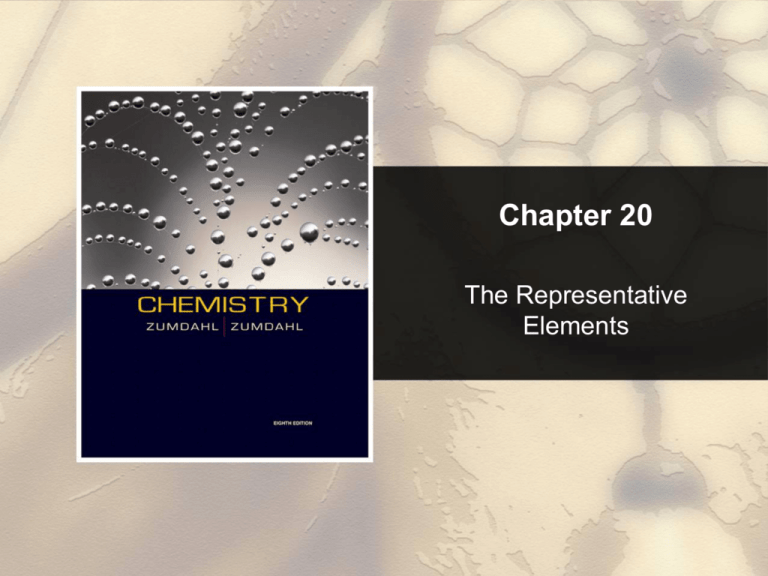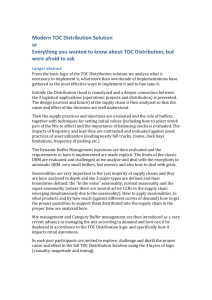
Chapter 20
The Representative
Elements
Chapter 20
Table of Contents
20.1
20.2
20.3
20.4
20.5
20.6
20.7
20.8
20.9
20.10
20.11
20.12
20.13
20.14
A Survey of the Representative Elements
The Group 1A Elements
The Chemistry of Hydrogen
The Group 2A Elements
The Group 3A Elements
The Group 4A Elements
The Group 5A Elements
The Chemistry of Nitrogen
The Chemistry of Phosphorus
The Group 6A Elements
The Chemistry of Oxygen
The Chemistry of Sulfur
The Group 7A Elements
The Group 8A Elements
Copyright © Cengage Learning. All rights reserved
2
Section 20.1
A Survey of the Representative Elements
Reviewing the Periodic Table Regions
• Representative elements:
Groups 1A – 8A (filling s and p orbitals)
• Transition elements:
Center of the table (filling d orbitals)
Return to TOC
Copyright © Cengage Learning. All rights reserved
3
Section 20.1
A Survey of the Representative Elements
Reviewing the Periodic Table Regions
• Lanthanides and Actinides:
Listed separately, on the bottom of the table
(filling 4f and 5f orbitals)
• Metalloids:
Separate metals from nonmetals
Return to TOC
Copyright © Cengage Learning. All rights reserved
4
Section 20.1
A Survey of the Representative Elements
The Atomic Radii of
Some
Representative
Elements (in
Picometers)
Return to TOC
Copyright © Cengage Learning. All rights reserved
5
Section 20.1
A Survey of the Representative Elements
Concept Check
Which should be the larger atom? Why?
Na
Cl
Return to TOC
Copyright © Cengage Learning. All rights reserved
6
Section 20.1
A Survey of the Representative Elements
Concept Check
Which should be the larger atom? Why?
Li
Cs
Return to TOC
Copyright © Cengage Learning. All rights reserved
7
Section 20.1
A Survey of the Representative Elements
Distribution of the 18 Most Abundant Elements
Return to TOC
Copyright © Cengage Learning. All rights reserved
8
Section 20.1
A Survey of the Representative Elements
Abundance of Elements in the Human Body
Return to TOC
Copyright © Cengage Learning. All rights reserved
9
Section 20.2
Atomic
The
Group
Masses
1A Elements
Alkali Metals: Sources and Methods of Preparation
Return to TOC
Copyright © Cengage Learning. All rights reserved
10
Section 20.2
Atomic
The
Group
Masses
1A Elements
Group 1A Oxides
• In the presence of excess oxygen:
4Li + O2
2Na + O2
K + O2
Rb + O2
Cs + O2
2Li2O
Na2O2
KO2
RbO2
CsO2
Return to TOC
Copyright © Cengage Learning. All rights reserved
11
Section 20.2
Atomic
The
Group
Masses
1A Elements
Exercise
Predict the products formed by the following
reactants:
Na2O2(s) + H2O(l) → NaOH(aq) + H2O2(aq)
Return to TOC
Copyright © Cengage Learning. All rights reserved
12
Section 20.3
The Chemistry
Mole
of Hydrogen
Hydrides
• Binary compounds containing hydrogen:
Ionic hydrides:
hydrogen + the most active metals
(eg; LiH, CaH2)
Covalent hydrides:
hydrogen + other nonmetals
(eg; H2O, CH4, NH3)
Metallic (interstitial) hydrides:
transition metal crystals treated with H2 gas
Return to TOC
Copyright © Cengage Learning. All rights reserved
13
Section 20.3
The Chemistry
Mole
of Hydrogen
Exercise
Predict the products formed by the following
reactants:
LiH(s) + H2O(l) → H2(g) + LiOH(aq)
Return to TOC
Copyright © Cengage Learning. All rights reserved
14
Section 20.4
The Group 2A Elements
Alkaline Earth Metals
• Very reactive
• Great practical importance:
Human life (Ca and Mg)
Return to TOC
Copyright © Cengage Learning. All rights reserved
15
Section 20.4
The Group 2A Elements
Ion Exchange
• Ca2+ and Mg2+ are often removed during ion
exchange, releasing Na+ into solution.
• Ion exchange resin – large molecules that have
many ionic sites.
Return to TOC
Copyright © Cengage Learning. All rights reserved
16
Section 20.4
The Group 2A Elements
A Schematic Representation of a Typical Cation Exchange Resin
Return to TOC
Copyright © Cengage Learning. All rights reserved
17
Section 20.5
The Group 3A Elements
• Group 3A elements generally show the increase
in metallic character in going down the group
that is characteristic of the representative
elements.
• B, Al, Ga, In, Tl
Return to TOC
Copyright © Cengage Learning. All rights reserved
18
Section 20.5
The Group 3A Elements
Some Physical Properties, Sources, and Methods of Preparation
Return to TOC
Copyright © Cengage Learning. All rights reserved
19
Section 20.5
The Group 3A Elements
Some Important Reactions
Return to TOC
Copyright © Cengage Learning. All rights reserved
20
Section 20.6
The Group 4A Elements
• Contains two of the most important elements on
earth: carbon and silicon.
• Can form four covalent bonds to nonmetals.
CH4, SiF4, GeBr4
Return to TOC
Copyright © Cengage Learning. All rights reserved
21
Section 20.6
The Group 4A Elements
Some Physical Properties, Sources, and Methods of Preparation
Return to TOC
Copyright © Cengage Learning. All rights reserved
22
Section 20.6
The Group 4A Elements
Some Important Reactions
Return to TOC
Copyright © Cengage Learning. All rights reserved
23
Section 20.7
The Group 5A Elements
• Exhibits varied chemical properties.
• N, P, As, Sb, Bi
Return to TOC
Copyright © Cengage Learning. All rights reserved
24
Section 20.7
The Group 5A Elements
Some Physical Properties, Sources, and Methods of Preparation
Return to TOC
Copyright © Cengage Learning. All rights reserved
25
Section 20.8
The Chemistry of Nitrogen
Nitrogen
• The great stability of the N N bond means that
most binary compounds containing nitrogen
decompose exothermically to the elements.
NO2(g)
½N2(g) + O2(g)
H = 34 kJ
N2H4(g)
N2(g) + 2H2(g)
H = 95 kJ
Return to TOC
Copyright © Cengage Learning. All rights reserved
26
Section 20.8
The Chemistry of Nitrogen
Nitrogen Fixation
• The process of transforming N2 to other
nitrogen–containing compounds.
• The Haber Process:
N2(g) + 3H2(g)
2NH3(g)
H = 92 kJ
Return to TOC
Copyright © Cengage Learning. All rights reserved
27
Section 20.8
The Chemistry of Nitrogen
The Nitrogen
Cycle
Return to TOC
Copyright © Cengage Learning. All rights reserved
28
Section 20.8
The Chemistry of Nitrogen
Nitrogen Hydrides
• Ammonia, NH3
Fertilizers
• Hydrazine, N2H4
Rocket propellant, manufacture of plastics,
agricultural pesticides
• Monomethylhydrazine, N2H3(CH3)
Rocket fuels
Return to TOC
Copyright © Cengage Learning. All rights reserved
29
Section 20.8
The Chemistry of Nitrogen
Nitrogen Oxides
• Nitrogen in its oxides has oxidation states from
+1 to +5.
In other compounds, nitrogen could have oxidation
states of -1 to -3.
Compound
N 2O
NO
N 2O 3
NO 2
HNO 3
Copyright © Cengage Learning. All rights reserved
Oxidation State of N
+1
+2
+3
+4
+5
Return to TOC
30
Section 20.8
The Chemistry of Nitrogen
Nitrogen Oxyacids
• Nitric acid, HNO3
hv
4HNO3 (l )
4NO2 (g ) + 2H2O(l ) + O2 (g )
• Nitrous acid, HNO2
HNO2 (aq )
+
2
H (aq ) + NO (aq )
Return to TOC
Copyright © Cengage Learning. All rights reserved
31
Section 20.8
The Chemistry of Nitrogen
The Ostwald Process
Return to TOC
Copyright © Cengage Learning. All rights reserved
32
Section 20.9
The Chemistry of Phosphorus
Allotropes of Phosphorus
• White Phosphorus = P4 (tetrahedral) - very
reactive
• Black Phosphorus = crystalline structure - much
less reactive
• Red Phosphorus = amorphous with P4 chains
heat, 1 atm, no air
P(white)
P(red)
P(white) or P(red)
P(black)
high pressure
Return to TOC
Copyright © Cengage Learning. All rights reserved
33
Section 20.9
The Chemistry of Phosphorus
Allotropes of Phosphorus
a) Pwhite
b) Pblack
c) Pred
Return to TOC
Copyright © Cengage Learning. All rights reserved
34
Section 20.9
The Chemistry of Phosphorus
Phosphorus Oxyacids
• Phosphoric acid, H3PO4
• Phosphorous acid, H3PO3
• Hypophosphorous acid, H3PO2
Return to TOC
Copyright © Cengage Learning. All rights reserved
35
Section 20.10
The Group 6A Elements
• O, S, Se, Te, Po
• Although in Group 6A there is the usual
tendency for metallic properties to increase
going down the group, none of the Group 6A
elements behaves as a typical metal.
• Can form covalent bonds with other nonmetals.
Return to TOC
Copyright © Cengage Learning. All rights reserved
36
Section 20.10
The Group 6A Elements
Some Physical Properties, Sources, and Methods of Preparation
Return to TOC
Copyright © Cengage Learning. All rights reserved
37
Section 20.11
The Chemistry of Oxygen
Oxygen
• O2 makes up 21% of the Earth’s atmosphere.
• O3 (ozone) exists naturally in the upper
atmosphere of the Earth.
Ozone layer absorbs UV light and acts as a
screen to prevent this radiation from
penetrating to the Earth’s surface.
Scientists have become concerned that
Freons and nitrogen dioxide are promoting
the destruction of the ozone layer.
Return to TOC
Copyright © Cengage Learning. All rights reserved
38
Section 20.11
The Chemistry of Oxygen
Ozone
3O2(g) 2O3(g)
K 1057
Return to TOC
Copyright © Cengage Learning. All rights reserved
39
Section 20.12
The Chemistry of Sulfur
• Sulfur is found in nature both in large deposits
of the free element and in ores such as galena,
cinnabar, pyrite, gypsum, epsomite, and
glauberite.
Return to TOC
Copyright © Cengage Learning. All rights reserved
40
Section 20.12
The Chemistry of Sulfur
Frasch Process
Return to TOC
Copyright © Cengage Learning. All rights reserved
41
Section 20.12
The Chemistry of Sulfur
Aggregates of Sulfur
Return to TOC
Copyright © Cengage Learning. All rights reserved
42
Section 20.12
The Chemistry of Sulfur
Sulfur Oxide Reactions
2SO2(g) + O2(g)
SO2(g) + H2O(l)
SO3(g) + H2O(l)
2SO3(g)
H2SO3(aq)
H2SO4(aq)
Return to TOC
Copyright © Cengage Learning. All rights reserved
43
Section 20.13
The Group 7A Elements
Halogens
• All nonmetals: F, Cl, Br, I, At
• Because of their high reactivities, the halogens
are not found as free elements in nature. They
are found as halide ions (X–) in various minerals
and in seawater.
Return to TOC
Copyright © Cengage Learning. All rights reserved
44
Section 20.13
The Group 7A Elements
Trends in Selected Physical Properties
Return to TOC
Copyright © Cengage Learning. All rights reserved
45
Section 20.13
The Group 7A Elements
Some Physical Properties, Sources, and Methods of Preparation
Return to TOC
Copyright © Cengage Learning. All rights reserved
46
Section 20.13
The Group 7A Elements
Preparation of Hydrogen Halides
H2(g) + X2(g)
2HX(g)
• When dissolved in water, the hydrogen halides
behave as acids, and all except hydrogen
fluoride are completely dissociated.
Return to TOC
Copyright © Cengage Learning. All rights reserved
47
Section 20.13
The Group 7A Elements
Halogen Oxyacids and Oxyanions
• All halogens except fluorine combine with
various numbers of oxygen atoms to form a
series of oxyacids.
• The strengths of these acids vary in direct
proportion to the number of oxygen atoms
attached to the halogen, with the acid strength
increasing as more oxygens are added.
Return to TOC
Copyright © Cengage Learning. All rights reserved
48
Section 20.13
The Group 7A Elements
The Known Oxyacids of the Halogens
Return to TOC
Copyright © Cengage Learning. All rights reserved
49
Section 20.14
The Group 8A Elements
Noble Gases
• He and Ne form no compounds.
• Kr and Xe have been observed to form
chemical compounds:
Xe(g) + 2F2(g)
XeF4(s) [6 atm, 400 C]
XeF6(s) + 3H2O(l)
XeO3(aq) + 6HF(aq)
Return to TOC
Copyright © Cengage Learning. All rights reserved
50
Section 20.14
The Group 8A Elements
Selected Properties
Return to TOC
Copyright © Cengage Learning. All rights reserved
51
Section 20.14
The Group 8A Elements
Concept Check
Which of the following groups is the most
reactive?
a) Group 1A Elements
b) Group 5A Elements
c) Group 6A Elements
d) Group 8A Elements
Return to TOC
Copyright © Cengage Learning. All rights reserved
52
Section 20.14
The Group 8A Elements
Concept Check
Which of the following groups does not contain
at least one element that forms compounds
with oxygen?
a)
b)
c)
d)
e)
Group 4A Elements
Group 5A Elements
Group 6A Elements
Group 7A Elements
All of these groups contain at least one element
that forms compounds with oxygen.
Copyright © Cengage Learning. All rights reserved
Return to TOC
53







